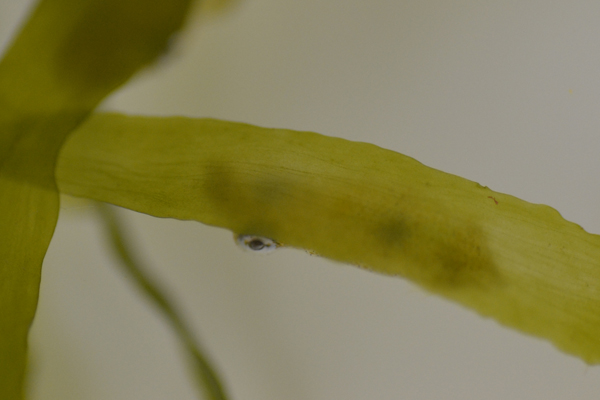Life History & Behaviour
Cephalopods display a huge diversity of life histories, lifestyles and behaviours. However, they are all carnivorous and many species are active and highly effective predators. There are many benthic species, particularly amongst the Octopus, however most cephalopods are adapted for a free swimming lifestyle (Ruppert et al. 2004) and I. notoides is no exception. It is thought that I. notoides is a nocturnal predator that uses its adhesive gland to attach to vegetation for cover during the day and detaches at night to actively hunt small crustaceans such as shrimp, which it rapidly immobilises by biting through the nerve cord (Norman and Reid 2000).
When introduced to novel surroundings in the lab during observations and experiments, I. notoides seemed inquisitive. Animals were observed 'exploring' the new environment and would approach the edges of the containers head first, touching the sides repeatedly with their tentacles, as if testing the boundaries. There is a report of a similar behaviour seen in captive specimens of I. pygmaeus, the two-toned pygmy squid, where animals would approach the surface of a tank with their arms extended and bump along it. This was interpreted by the researcher as feeding behaviour, and termed ‘nibbling’ (Moynihan 1983). It is unclear whether this is what was occurring during observations of I. notoides, but it cannot be ruled out. Another possibility is that it may have been a response to the reflection of the animal in the glass of the tank or dish, which deceived it into believing it was interacting with another animal. However, no observations of two animals approaching each other in this manner were made during the current study. It was also noted that I. notoides would typically come to rest attached to the underside of vegetation fronds, if these were available, and it was often hard to see animals even in small containers.
 |
|
I. notoides attached to the underside of Caulerpa sp. The body shape is just discernable through the frond and the eye can be seen peeking from underneath. Photograph by Samantha Reynolds.
|
During preliminary observations for the experiment on substrate preference (see Substrate Preference Experiment tab), I. notoides was placed in clear petri dishes over a variety of different coloured and patterned backgrounds in order to note any reaction to these, such as a change in body colour and/or pattern. Substrates of different colours, patterns and contrast levels, including checkerboard patterns with different sized checks, have been shown to elicit different camouflage body patterns in Cuttlefish (Sepia sp.) (e.g. Allen et al. 2010). However during observations of I. notoides on different backgrounds, substrate colour did not seem to have much of an effect on the animals' body colouration. Rather than changing colour in response to the substrate, it seemed that colour change in I. notoides was more likely to be elicited in response to the presence of conspecifics or to attempts to catch it. However, this was not formally tested.
Cephalopods are known to change their body colour, pattern and texture (see Predator Avoidance Strategies and Integumentary System tabs) as a means of camouflage (Hanlon 2007), but they also use this unique ability to communicate intraspecifically and also to signal to other animals, such as during courtship or aggression displays (Messenger 2001). The possibility that cephalopods also have a 'private ' or 'hidden' means of communicating with each other has been proposed, because few animals are able to see polarised light but cephalopods can both see and produce it (from the iridiophores - see Integumentary System and Sensory Systems tabs) (Mäthger et al. 2009).
Because of their large and complex central nervous system and highly developed sensory systems, cephalopods are able to engage in learning. Various species have been shown to exhibit sensitisation (an increase in the response to a stimulus when rewarded), habituation (the waning of a response to a repeated stimulus) and are also capable of associative learning (where ideas or experiences that occur at the same time can be linked together, i.e. become associated with one another) (Mather and Kuba 2013). There has also been some suggestion that cephalopods may have some form of primary consciousness (Mather 2008).
Please see the tabs for more information on the life history and behaviour of cephalopods in general and I. notoides in particular. |